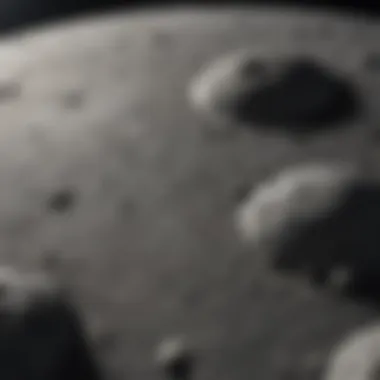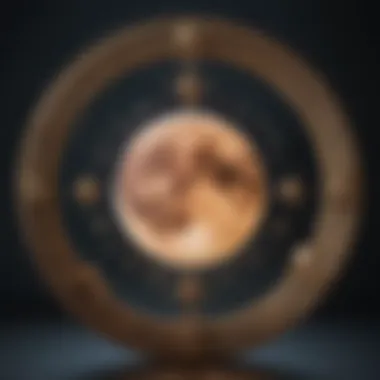Exploring the Moon Cycle: Tonight's Celestial Influence


Intro
The moon cycle is not just a series of phases; it holds significance for many, particularly in the realm of astrology. Each phase of the moon can represent different emotional states and influences. Tonight’s celestial position can reveal key insights into our personal and collective experiences. For astrology enthusiasts, understanding the moon's influence may enhance introspection and guide decision-making.
In this article, we explore the depth of the moon cycle, providing a historical and cultural context while focusing on its current implications. We will investigate the traits associated with each zodiac sign, compatibility insights within relationships, and significant astrological events that shape our daily lives. Through this exploration, we aim to offer a digestible guide to navigating the complexities of emotional and astrological landscapes shaped by the lunar phases.
Zodiac Profiles
Understanding each zodiac sign provides a framework for recognizing how the moon's current phase might influence individual behavior and emotional responses.
Overview of Each Sign
The twelve zodiac signs each embody distinct characteristics. They present unique perspectives that shape actions, emotions, and important decisions.
Personality Traits
- Aries: Bold, impulsive, dynamic.
- Taurus: Loyal, practical, steadfast.
- Gemini: Adaptable, argumentative, curious.
- Cancer: Nurturing, sensitive, protective.
- Leo: Charismatic, confident, dramatic.
- Virgo: Analytical, meticulous, reserved.
- Libra: Diplomatic, graceful, indecisive.
- Scorpio: Intense, passionate, secretive.
- Sagittarius: Adventurous, optimistic, straightforward.
- Capricorn: Disciplined, ambitious, conservative.
- Aquarius: Innovative, independent, rebellious.
- Pisces: Compassionate, intuitive, emotional.
Strengths and Weaknesses
Each sign possesses inherent strengths and weaknesses:
- Aries: Strong leadership but can be reckless.
- Taurus: Stability leads to safety, but stubbornness prevails.
- Gemini: Quick-witted yet prone to inconsistency.
- Cancer: Deep loyalty, however, high sensitivity can cause retreat.
- Leo: Natural leadership, though, conceit can be problematic.
- Virgo: Analytical strength can turn to overthinking.
- Libra: Harmony-seeking can lead to indecision.
- Scorpio: Passionate strength is often coupled with jealousy.
- Sagittarius: Optimism uplifts yet can lead to carelessness.
- Capricorn: Determination drives success, but can breed inflexibility.
- Aquarius: Innovative thinking promotes progress, though often rebellious.
- Pisces: Intuition is a gift, but emotions can cloud judgment.
Compatibility Insights
Relationships can be influenced by both personal traits and the lunar cycle. Understanding compatibility can facilitate healthier connections.
Love and Relationships
Love compatibility often revolves around specific interactions between signs. Certain signs inherently work better together, while others may clash. Recognizing these dynamics at the time of lunar phases can enhance mutual understanding.
Friendship Compatibility
Friendships are built on shared interests and understanding. Zodiac signs can show how friendships may thrive or face challenges.
Workplace Dynamics
In professional environments, zodiac traits often contribute to team synergies or tensions. The influence of the moon cycle may affect colleague interactions and work-related decisions.
Astrological Events
Astrological events contextualize the influence of the moon cycle, guiding our responses and thoughts.
Monthly/Weekly Horoscope Breakdown
Keeping track of horoscopes can enhance understanding of how the moon influences different signs over specific time frames.
Notable Celestial Events
Important dates such as eclipses or supermoons may amplify emotional responses or shift decision-making processes significantly.
How to Prepare for Astrological Shifts
Awareness is key for effectively navigating astrological shifts. Preparation can enhance your emotional resilience and decision-making ability.
The moon is a powerful symbol in astrology, influencing our emotions and guiding introspection. Understanding its cycles can enrich personal insights.
By delving into the moon's current phase, astrology enthusiasts can gain perspectives that resonate deeply within, fostering a better understanding of themselves and the world around them.


Understanding the Moon Cycle
Understanding the moon cycle is integral to comprehending its influence on human behavior and emotions. Each phase of the moon carries its unique energy and symbolism, affecting everything from our moods to our personal ambitions. This section explores the mechanics behind the moon cycle and its significance in astrology, personal growth, and daily living.
What is a Moon Cycle?
A moon cycle, also known as a lunar cycle, lasts about 29.5 days. It is the period from one new moon to the next. The changing phases of the moon are a reflection of its position relative to the Earth and the Sun. As the moon orbits Earth, different portions of its illuminated side are visible from our vantage point. This cycle has profound effects on various aspects of life, including agriculture, cultural events, and personal introspection.
Phases of the Moon
The moon transitions through six distinct phases: New Moon, Waxing Crescent, First Quarter, Waxing Gibbous, Full Moon, and Waning Crescent. Each phase influences mood, behavior, and decision-making in unique ways. Here is a closer examination of each phase:
New Moon
The new moon marks the beginning of the moon's cycle. It symbolizes new beginnings and is considered an ideal time for setting intentions. During this phase, the moon is not visible, which gives a sense of quietude and introspective energy. This absence of light is beneficial for those who seek to reflect and plan ahead, making it a popular choice for self-assessment exercises.
Waxing Crescent
As the moon enters its waxing crescent phase, it begins to reappear as a slender sliver of light. This phase represents growth and movement. It is an auspicious time for taking action on intentions set during the new moon. The energy of this phase encourages experimentation and exploration, allowing individuals to gradually build towards their goals.
First Quarter
The first quarter phase is when the moon appears half-illuminated. This is a crucial point in the moon cycle, marking a time of decision and challenge. It is an excellent moment for reassessing intentions and figuring out what works and what does not. The energy during this phase is dynamic, urging individuals to confront obstacles and commit to their paths.
Waning Gibbous
The waning gibbous phase occurs after the full moon. It is a time for gratitude, reflection, and integration of experiences. As the moon begins to disappear from the sky, this phase offers a chance to focus on what has been learned during the previous weeks. It encourages personal growth and healing as individuals assess their progress.
Full Moon
The full moon is often celebrated for its heightened energy and illumination. It is a time of culmination, clarity, and abundance. During this phase, emotions can run high, and it is a moment for release—letting go of what's no longer needed. Many individuals engage in rituals during this phase to harness its potent energy for transformation and healing.
Waning Crescent
The waning crescent is the final phase before the new moon. It symbolizes closure and reflection. This phase calls for introspection, allowing individuals to release the past and make space for new beginnings. It serves as a time to rest, recharge, and prepare for the new cycle ahead.
Lunar Influence on Earth
Lunar influence extends beyond personal emotions; it has tangible effects on our planet. The moon's gravitational pull affects ocean tides and may even influence animal behavior. Understanding these connections can deepen one's appreciation of the moon's role in greater ecological systems.
Tonight's Lunar Phase
Understanding the current lunar phase is essential for those interested in the moon's impact on life and emotions. This section sheds light on the specific lunar phase tonight, revealing how it can shape behavioral patterns and emotional states. The moon's position illustrates a cycle that deeply influences personal and collective experiences. Acknowledging these lunar energies can lead to more informed, intentional living.
Current Moon Phase Overview
At this moment, the moon is positioned in its Waxing Gibbous phase. This phase follows the First Quarter and precedes the Full Moon. During this time, the moon appears more than half illuminated but not yet fully bright. The Waxing Gibbous phase is crucial for planning and preparation. This is a period characterized by expansion and growth, making it an ideal time for setting intentions and taking tangible steps towards goals. As the moon grows fuller, so do the energies of enthusiasm and vitality. The current lunar light encourages us to focus on what can be achieved and nurtured.
Astrological Significance of Tonight's Phase
The Impact of Moon Phases on Emotions
The moon phases significantly affect our emotions. As we transition through each phase, the energies shift, evoking different emotional responses. The Waxing Gibbous phase brings forth feelings of hope and initiative. This can result in increased motivation as individuals feel encouraged to pursue their ambitions. It is a time when clarity often emerges from previous introspections. Emotions tend to heighten during this phase, presenting both advantages and challenges. Being aware of these emotional tides allows for better self-management and understanding.
Personal Growth Opportunities
Personal growth opportunities are abundant during this phase. As we approach the Full Moon, it invites a sense of culmination and assessment of progress. Reflecting on what has unfolded since the New Moon can reveal deep insights into personal growth. This phase encourages individuals to identify obstacles and harness newfound strengths to overcome them. The intention-setting aspect during this phase is potent, as energy is available to initiate change and development. It is a prime opportunity for self-discovery and enlargement of personal aspirations.
Continuous awareness of the moon's cycles allows individuals to live in harmony with natural rhythms, enhancing personal endeavors and emotional balance.
In essence, tonight's lunar phase presents a significant opportunity. By engaging with these natural influences, individuals can harness the moon's power for emotional clarity and personal advancement.


Cultural Perspectives on the Moon
Understanding the cultural perspectives about the moon gives insight into human behavior, beliefs, and traditions. The moon is not just a celestial body; it has a significant impact on various cultures throughout history. Exploring these perspectives allows us to appreciate the interdisciplinary links between astronomy, astrology, and social practices. The moon serves as a symbol of femininity, intuition, and cycles, thus influencing rituals, folklore, and spiritual practices.
Historical Significance of the Moon
Throughout history, many civilizations have placed great importance on the moon. Ancient peoples used the lunar cycle for agricultural planning, marking important times for planting and harvesting. The moon also served as a timekeeper, providing a framework for calendars in societies such as the Chinese, Islamic, and Hebrew cultures.
This historical reliance on moon cycles illustrates how its phases were critical to daily life, ensuring that individuals acted in harmony with nature. Additionally, myths and stories surrounding the moon have emerged from these societies, contributing to their cultural identity and providing explanations for natural phenomena.
Lunar Worship Across Cultures
Indigenous Practices
Indigenous practices are often rooted in a deep connection with natural elements, including the moon. Many Indigenous cultures view the moon as a guiding force, representing fertility and fertility cycles. Here, rituals are timed according to lunar phases, influencing everything from hunting to ceremony cycles.
The key characteristic of these practices is their communal aspect. They are holistic, often integrating storytelling, music, and dance. This is a beneficial choice for understanding cycles because it presents a harmonious way of life that fosters community bonding.
A unique feature of Indigenous lunar practices is the emphasis on stewardship of the Earth. This approach is advantageous in today's sustainability discussions, offering insights and lessons relevant for contemporary environmental issues, although it may lack the structure found in organized religion.
Modern Interpretation
Modern interpretations of lunar worship have evolved with a focus on personal spirituality and self-awareness. Many people today engage with the moon through practices such as moon circles and lunar meditations. The key characteristic of these contemporary practices is the emphasis on personal empowerment and intention-setting during specific moon phases. This trend reflects a growing interest in self-discovery and holistic approaches to life.
A unique feature of modern lunar interpretations is the access provided by social media and online communities. This facilitates connection and shared experiences among individuals interested in astrological insights. However, this decentralization can lead to varying interpretations, which may undermine the coherence of traditional lunar worship.
It is evident that the perspectives of the moon vary greatly across cultures, yet the connection remains strong.
Astrology and the Moon
Astrology holds a significant position within the realm of lunar studies. It allows individuals to connect the cycles of the moon with personal experiences and emotions. The moon serves as a powerful symbol in astrology, representing our inner selves, instincts, and emotions. Its phases and positions can provide insights into our behaviors and decision-making processes.
Understanding the moon's astrological influence can enhance one’s awareness of personal patterns and cycles. For instance, each lunar phase may evoke different emotional states and energies, affecting how individuals approach various aspects of their lives, such as relationships, work, and creativity.
The Moon in Zodiac Signs
Each zodiac sign imbues the moon with distinct characteristics when it transits through them. The moon moves through all twelve signs in approximately 29.5 days. This journey creates varying energies based on the sign it occupies, influencing people's emotions and behaviors.
- Aries: Impulsive, initiating energy that encourages quick decisions.
- Taurus: Stability and comfort, focusing on material needs and values.
- Gemini: Curiosity and communication, promoting social interactions.
- Cancer: Emotional depth and sensitivity, prioritizing home and family.
- Leo: Creativity and self-expression, encouraging confidence.
- Virgo: Practicality and analysis, perfect for organization.
- Libra: Balance and partnerships, enhancing social dynamics.
- Scorpio: Intensity and transformation, urging deep introspection.
- Sagittarius: Adventure and expansion, encouraging exploration.
- Capricorn: Ambition and structure, suitable for long-term planning.
- Aquarius: Innovation and originality, fostering new ideas.
- Pisces: Intuition and imagination, encouraging emotional flow.
The interplay between the moon and these signs has profound implications for personal growth and understanding.
Moon Sign vs.
Sun Sign
In astrology, the sun sign is commonly recognized, usually derived from one’s birth date. However, the moon sign plays an equally vital role, representing one's inner self and emotional landscape. While the sun reflects external personality traits and ego, the moon is about how individuals respond emotionally and intuitively.
- Sun Sign: Represents core identity and conscious self-expression.
- Moon Sign: Reflects inner feelings, instincts, and unconscious responses.
Knowing one’s moon sign can provide deeper insights into emotional reactions, enhancing self-awareness.
"Understanding both the sun and moon signs creates a more holistic view of one's astrological profile. This can lead to profound personal insights and growth."
In astrology, combining these influences allows individuals to navigate their lives with greater clarity, revealing the intricate layers of personality and emotional depth.
Practical Applications of Moon Cycle Insights
Understanding the practical applications of the moon cycle can significantly enhance one’s personal growth and emotional well-being. The lunar phases provide a framework for assessing one’s feelings and behaviors throughout the month. By aligning personal goals with the moon’s cycle, individuals can harness its energy effectively.


Using the moon as a guide can lead to more informed decision-making. Knowing when to act, reflect, or let go is crucial. For example, during a new moon, it is often said to be the best time for setting intentions. As the moon waxes, energy builds, making it a great time for action and implementation. Conversely, the waning phase invites introspection and release. This understanding can enhance clarity in one’s life.
Moreover, the influence of moon phases touch multiple aspects of life, such as:
- Emotional state: Certain phases can heighten emotions. For instance, around the full moon, people frequently feel more intense emotions.
- Creativity: Many artists and creatives find that their inspiration ebbs and flows with the lunar calendar.
- Health and wellness: The moon can affect physical health, often influencing sleep patterns and stress levels.
By actively considering these elements, individuals can better navigate their lives and make more intentional choices.
Using the Moon Cycle for Personal Development
The moon provides a rhythmic guide that can support personal development practices. Every lunar phase presents a unique opportunity for reflection and growth. Each phase can be utilized to work on specific areas, empowering individuals to make substantial progress in their lives.
New Moon
- This phase is perfect for self-reflection. It is important to think about new beginnings and set objectives for the month ahead. This time should be used to journal and clarify aspirations.
Waxing Moon
- It is a period to take action. Now is the time to initiate projects or implement ideas conceived during the new moon. Visualization techniques can be beneficial during this phase.
Full Moon
- A time of culmination, where results of efforts become visible. Reflect and celebrate achievements. It's also suitable for letting go of what no longer serves.
Waning Moon
- Ideal for introspection and release. Evaluate progress. Use this time to meditate on what can be discarded and make space for new intentions in the next cycle.
This structured approach allows for continuous self-improvement, guided by the natural rhythm of the moon.
Setting Intentions Aligned With Lunar Phases
Aligning personal intentions with lunar phases can help individuals flow more easily with life's cycles. By being mindful of the moon's phases, one can set intentions that align with the natural energetic shifts in the universe.
- Reflect during the New Moon: Take time to clarify what you wish to achieve. Write your intentions down. This setting of goals correlates well with the moon’s new beginnings.
- Act during the Waxing Moon: Consider taking concrete steps to pursue these intentions. This phase supports growth and momentum. Focus on your activities.
- Release during the Full Moon: Assess what has manifested. Acknowledge successes, but also recognize what isn't working. Let go of unhelpful patterns.
- Revise during the Waning Moon: Revisit intentions. Make necessary adjustments. Reflect on the past month and reset for the new one ahead.
These strategies can foster a more intentional way of living. Embracing the lunar cycle can deepen connection to oneself as well as to nature's rhythms.
The End
Understanding the moon cycle is more than just observing its phases. It serves as a profound tool for personal introspection and growth. In this article, we have explored various aspects of the moon cycle, particularly focusing on tonight's celestial influence.
This phase brings its own unique energy, impacting our emotions and thoughts. Recognizing these influences allows individuals to make informed decisions in their personal and professional lives. It is essential to consider the interplay between the moon's position and individual astrological signs, as this can amplify the broader lunar effects.
The relevance of these lunar cycles extends beyond mere observation. By engaging with the moon cycle actively, individuals can align their lives more harmoniously with the universe’s rhythms. This alignment can yield benefits such as enhanced emotional clarity, improved decision-making, and an overall sense of purpose.
Of particular note is tonight's phase, which serves as a reminder of the significance of cycles in life. Just as the moon waxes and wanes, so too do our lives experience phases of growth, reflection, and renewal. Embracing the insights offered by watching the moon can lead to profound personal transformation.
Reflecting on Tonight's Moon Cycle
Tonight's lunar phase offers a unique opportunity for introspection. As the moon casts its light on our lives, it is a time to pause and reflect. Individuals can examine their emotional states and identify patterns that may be linked to the lunar influence.
The current phase often signifies shifts in energy, prompting people to assess their goals and desires. Are they aligned with what truly matters? Engaging with this question provides clarity and can initiate the process of setting intentions.
Moreover, tonight's specific phase can bring about certain feelings or behaviors. Some may feel increased creativity or heightened sensitivity. Recognizing these influences can enhance personal awareness and lead to more balanced emotional responses. It becomes crucial to document these feelings, as over time, a pattern may emerge that reveals deeper truths about oneself.
Embracing Lunar Insights in Daily Life
Integrating lunar insights into daily life can foster personal growth and enhance self-awareness. This approach begins with observing the moon's phases and noting how they coincide with one's emotional landscape and experiences.
For practical application, consider the following steps:
- Keep a Moon Journal: Documenting your feelings throughout the moon cycle helps in recognizing patterns and prompts for future action.
- Set Lunar Intentions: Use the energy of each lunar phase to set goals that resonate with your current emotional state. This connection can amplify success.
- Engage in Rituals: Simple rituals such as lighting candles or practicing meditation during specific moon phases can enhance focus and intention.
By incorporating these practices, individuals can deepen their relationship with the lunar cycle. The endeavor to align actions and decisions with lunar cycles can lead to a more fulfilling and grounded lifestyle.
Recognize that, while the moon may be a distant celestial body, its influence is a constant reminder of life's cyclical nature, urging us to reflect, grow, and thrive.



